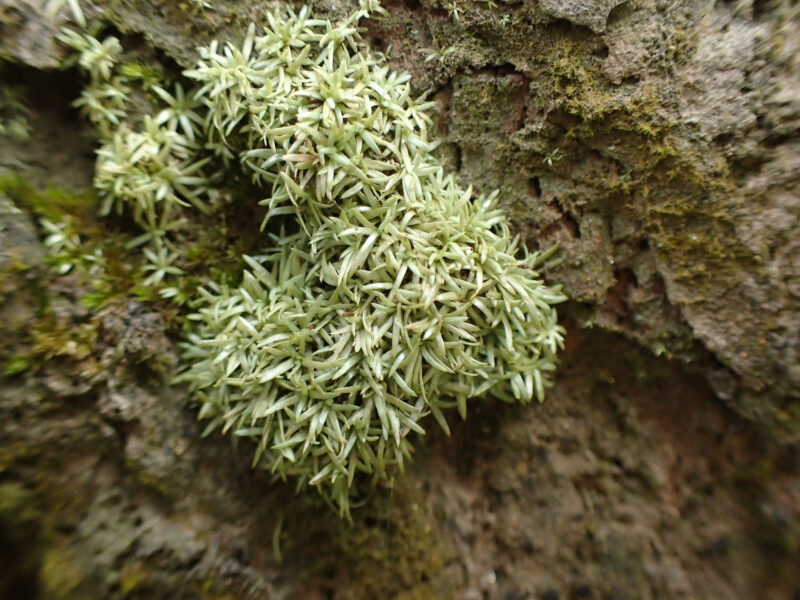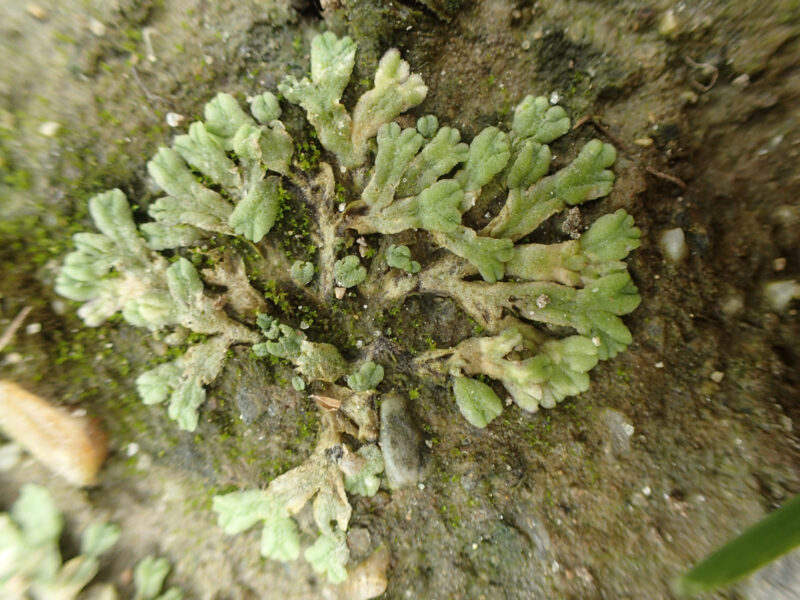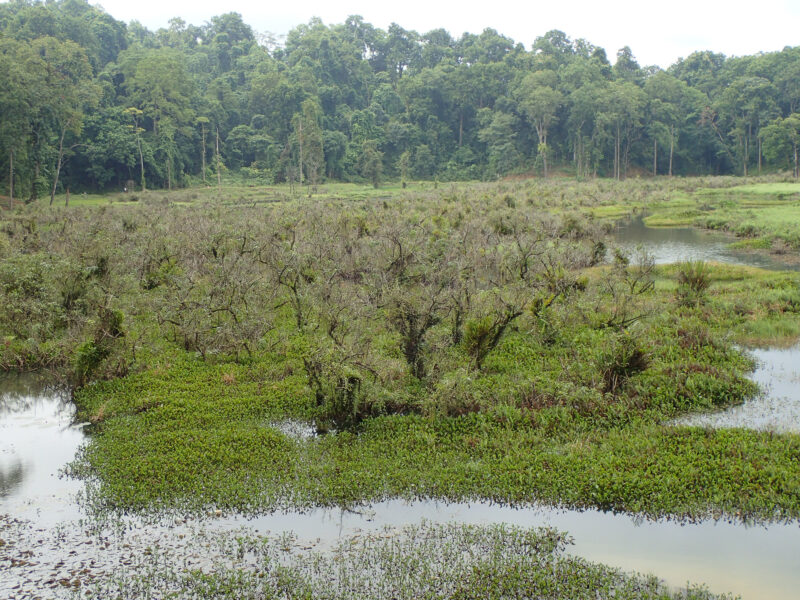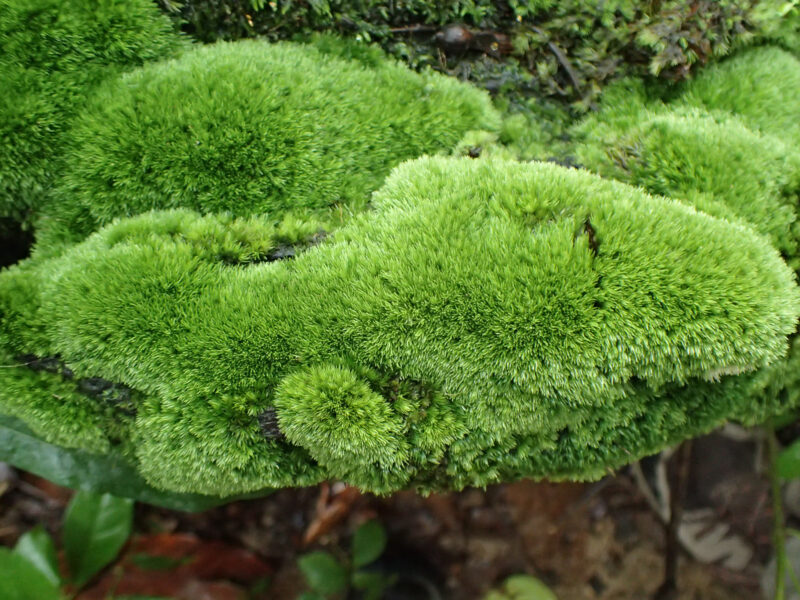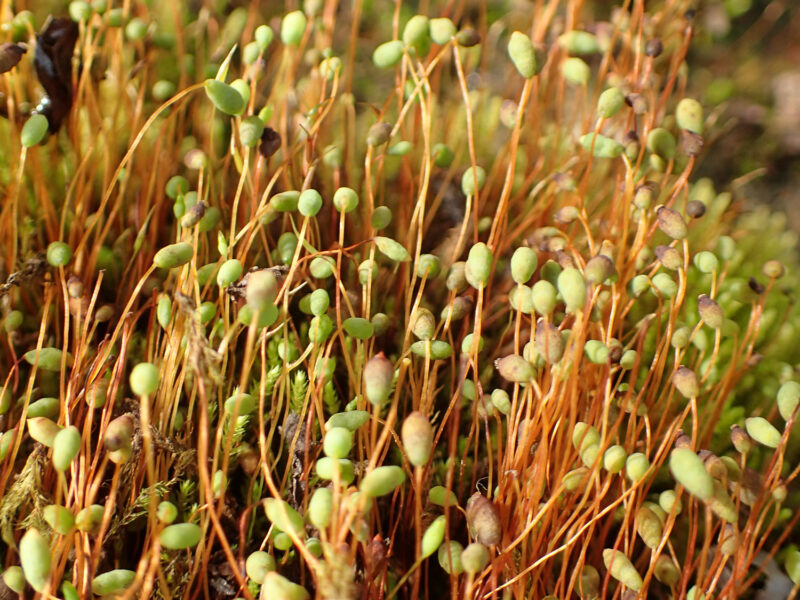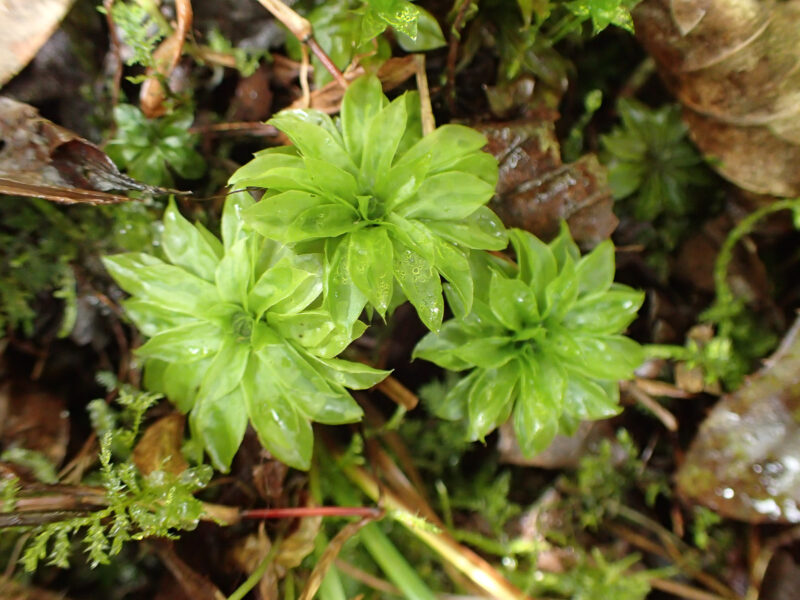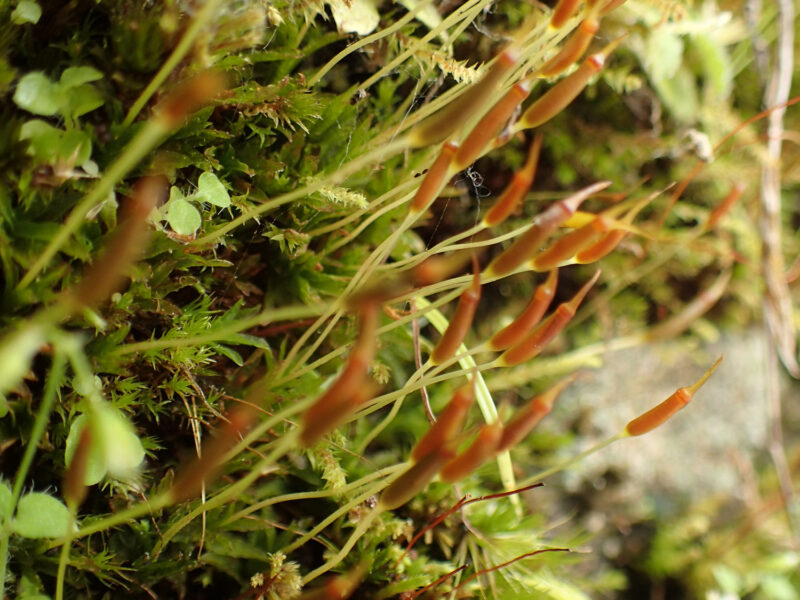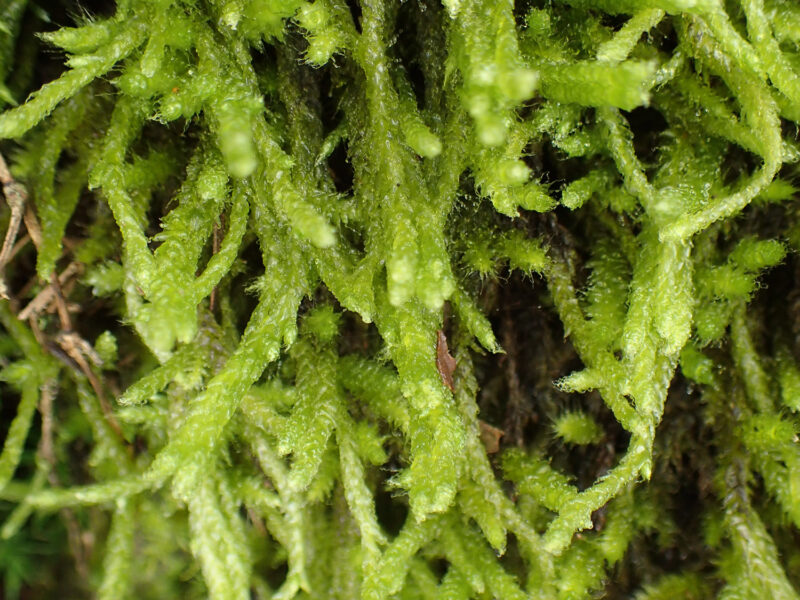Bryophyte exploration of southeast Nepal, September 2022
David Long
At 9.30 am on 5 September 2022 as I landed in Kathmandu I got my first view of the Kathmandu Valley since my last visit in 2001. Having recently published a review of the bryophytes collected by Nathaniel Wallich in 1820–21 (Long 2022), mostly in the Kathmandu Valley, Nepalese bryophytes were very fresh in my mind and I was looking forward to re-acquainting myself with some of the genera and species Wallich discovered. In Kathmandu I met up with my fellow-travellers – Mark Watson from RBG Edinburgh, leader of the Flora of Nepal Project, Ian Wall, one of our RBGE Trustees, and Norbert Holstein from the Natural History Museum in London, a curator and angiosperm taxonomist. We also met our Nepalese colleagues, including Pratiksha Shrestha, a bryologist from the Department of Plant Resources, who was to join us for bryological field training. Three days later, after official meetings, shopping and packing, our group was on a small turbo-prop plane heading east to the small airport at Bhadrapur, in the southeast corner of Nepal, close to the Indian border. Sadly, the high Himalayan peaks to the north were obscured by cloud – this was still the monsoon season and we could expect a fair bit of rain – correctly as it turned out!
Our group leader was Lila Sharma, head of the NGO Forest Action Nepal, dedicated to restoring to good condition some of the degraded forests in the Tarai – the strip of lowland Nepal, scarcely over 100 m altitude, along the southern border with India. Our task was to survey plant diversity in three target areas of forest in the south-east corner of Nepal, in Jhapa, Morang and Panchthar Districts. To complete our team we had three excellent botanists from Kathmandu – Yogendra Poudel, Dhanraj Khandel and Sangeeta Rajbhandari, along with local forestry staff. Following eradication of the once-endemic malaria, much of the tarai has been converted into agricultural land and tea gardens, but a few forest areas have survived, particularly ‘Sal’ forest – dominated by the tree Shorea robusta in the Dipterocarpaceae.
Jalthal Sal forest
The first area we surveyed was part of the protected Jalthal forest, only about 90 m above sea level, the lowest part of Nepal, close to the town of Birtamode where we were accommodated in a comfortable hotel. We spent four days walking into different parts of the forest (which was surrounded by a very robust electric fence to contain the wild elephants which roam freely within the forest). It took us several days to acclimatize to the extremely hot and humid weather, not to mention some torrential downpours. Sal, one of the most valuable and durable of Indian timbers, dominated the forest but it appeared that through selective logging in the past only relatively young trees were seen. The lack of older trees probably explained the scarcity of epiphytes. Those epiphytes we did see were a Lopholejeunea sp., [until the specimens come to Edinburgh, names are provisional] which was very black in colour and closely appressed to the bark, whitish cushions of Octoblepharum albidum, looking rather like a Leucobryum, and a species of Calymperaceae, probably Syrrhopodon. To my surprise the forest contained some large termite mounds, though these appeared to support only one moss – a Fissidens. Other mosses, mostly pleurocarps, were found on logs and stumps and some damp brickwork was covered in a Hyophila, almost certainly the common H. involuta. On the muddy footpaths were at least three species of Riccia, which may be troublesome to identify, and also on soil was the distinctive moss Garckea flexuosa (Ditrichaceae) with its capsules hidden amongst the perichaetial leaves. In spite of the humidity it was possible to get our bryophyte specimens dry using a couple of fans purchased in Birtamode, unlike the flowering plant people who used a drying frame heated by kerosene stoves.
Raja Rani Lake
Our next area of study, thankfully at slightly higher elevation in the outermost Himalayan foothills (around 500 m), was near the town of Letang in Morang District, where our small out-of-town hotel ‘Top Hill Homestay’, was quirky but pleasant. The main place of interest was a lake, known as Raja Rani Lake, surrounded by forests of Sal and other tree species. The bryophyte flora in the forest was more varied than at Jalthal, with several epiphytes such as Herpetineuron toccoae (Thuidiaceae) and a small Bryum on concrete steps which may turn out to be Anomobryum apiculatum, described from Wallich’s collections as Bryum nitens Hook. ex Harv. On a fallen log was a splendid colony of a Leucobryum, possible L. humillimum. We also collected at least two species of the tropical thalloid liverwort genus Cyathodium, and a hornwort which may be a Megaceros was expertly detected by Pratiksha. The lake itself was of special significance for its populations of the small aquatic tree Cephalanthus tetrandra (Rubiaceae) which was out of reach in the water but tantalizing epiphyte cover could be seen from the bank. Lila was very keen for us to sample the bryophytes on the trees, and as the lake is something of a tourist attraction, a few pedalo boats were available for hire. One of these was brought alongside and four of us set out into the lake – a novel bryophyte collecting experience, not quite the same as our recent boat trips on Jura. We were soon getting tangled in the spiky branches but managed to sample the dominant bryophytes, mostly mosses including a Macromitrium species, a small Lejeunea, and to my great surprise an epiphytic Aneura which was collected in silica gel for DNA sequencing. Back at the hotel we could process specimens on the airy flat roof and thanks to my spacious bedroom I could set up a drying fan and bryophyte packets on the spare bed, and enjoy the cool breeze from the fan!
Kamphutar
The third of our study areas involved a rather hair-raising drive in our two rented jeeps up into the foothills proper, through pouring rain and mist along a very rough and rocky road with hairpins and steep drops, finally reaching the Matribhumi Tea Estate at just under 1700 m. The estate included a comfortable guest house where we could sit around an open fire in the evening. Our angiosperm botanists stayed here for four nights to collect in the nearby forests, while we (cryptogamists – two bryologists, two pteridologists, and our leader Lila) set out again the next day on another slippery and bumpy drive to the village of Kamphutar at 1770 m, where Lila had previously seen evergreen oak forests on the slopes of Miklajung Mountain, where he said the trees were dripping with epiphytic bryophytes. On the way we could look down into the big Tamur River valley far below where we had trekked on our way up to Kanchenjunga in 1989. We stayed in Kamphutar for two nights in a small rather basic but perfectly comfortable hotel. A short afternoon walk out of the village brought us to a damp shady road cutting – always an interesting habitat for ephemeral mosses and thalloid liverworts. As well as abundant fruiting Trematodon longicollis and a fine Asterella, what really caught my eye were large rather beautiful stands of what I’m pretty sure is Pohlia flexuosa, with both axillary bulbils and abundant sporophytes. This is one of the species first discovered in Nepal by Wallich, with suberect capsules borne on long flexuose setae (hence the name) on the original type specimens, though I’d never seen any sporophytes in Britain.
Miklajung mountain
Next day (Sunday 17th September) turned out to be the bryological (and scenic) highlight of the whole trip. We set out early for Miklajung mountain, hoping to drive up a very rough track up into the evergreen oak forest at around 2000 m, but as we drove out of the village we stopped suddenly when we saw that the clouds to the north had lifted and a superb panorama of snowy Himalayan peaks was revealed in all its glory – from Kangchenjunga in the east, (where we trekked to in 1989 from the Nepalese side, and from the east side in Sikkim in 1992), extending west to the Everest peaks and Makalu, to which we had trekked in 1991. Happy memories! Soon after, the peaks vanished behind the clouds. The next excitement came as we drove up a very narrow twisty track in the forest to be confronted by a fallen tree blocking our way with no room to turn on the edge of a vertical drop. I got out of the jeep very hurriedly as the driver tried but failed to turn around. Eventually he reversed back down to safety, while we had a longer walk up into the oak forest.
Forty-four bryophyte collections from the mossy forest made it the best day of the trip, and it included several robust pleurocarpous mosses in the Meteoriaceae including Meteorium buchananii (discovered in Nepal by the Scottish botanist Francis Buchanan in 1802-03), Aerobryidium filamentosum and Meteoriopsis reclinata. The most spectacular moss of course was the aptly named Rhodobryum giganteum, first discovered by Nathaniel Wallich in 1821 and described by C.F. Schwägrichen. The mossy trees and rocks had other pleurocarps such as Trachypodopsis serrulata and Bryowijkia ambigua, and by the track a really special Atrichum, A. flavisetum which was easily recognised by its polysetous sporophytes with yellow setae. This species is included in the British checklist though it has not been seen in Britain for many years, and was reported in the past as both Atrichum undulatum var. haussknechtii and var. gracilisetum – further investigation needed! Liverworts collected included Targionia hypophylla and the very distinctive Metacalypogeia alternifolia, a very pretty little species which does not deserve such a mouthful of a generic name. Lila’s prediction of a rich harvest of bryophytes was fully vindicated.
And finally…
The following day we had to head back to the tea estate to re-join our colleagues and enjoy a guided tour of organic tea cultivation and processing (and buy some of the excellent tea), then it was down more hairpin bends (but on a good road!) to the steamy plains to the metropolis of Dharan where more luxurious accommodation with hot showers awaited us, and a rather splendid restaurant dinner to round off the field work. Next day we had to meet the local mayor who turned out to be a refreshingly unusual politician, very aware of the environmental pressures on the local forests and wildlife, and very keen to get Lila’s Forest Action Nepal to come back to his patch to encourage forest restoration. Next day we drove south to the airport at Biratnagar where Buddha Air transported us back to Kathmandu in only 45 minutes.

Patan temple restoration
The remaining five days were spent in Kathmandu, mostly in the herbarium at the Godavari Botanical Garden, where collections had to be fully dried and sorted, before packing up for shipment back to Edinburgh. Other activities included shopping and some sightseeing in the Patan area, where restoration of the damage to the historic temples caused by the huge earthquake in April 2015 is still a major undertaking requiring considerable overseas funding and expertise.
Reference
Long, D.G. 2022. The bryophytes of the Wallich Herbarium and Catalogue. Acta Bryolichenologica Asiatica 11: 1–101.
Published: 12 November 2022







